The Intel Comet Lake Core i9-10900K, i7-10700K, i5-10600K CPU Review: Skylake We Go Again
by Dr. Ian Cutress on May 20, 2020 9:00 AM EST- Posted in
- CPUs
- Intel
- Skylake
- 14nm
- Z490
- 10th Gen Core
- Comet Lake
CPU Performance: Encoding Tests
With the rise of streaming, vlogs, and video content as a whole, encoding and transcoding tests are becoming ever more important. Not only are more home users and gamers needing to convert video files into something more manageable, for streaming or archival purposes, but the servers that manage the output also manage around data and log files with compression and decompression. Our encoding tasks are focused around these important scenarios, with input from the community for the best implementation of real-world testing.
All of our benchmark results can also be found in our benchmark engine, Bench.
7-zip v1805: Popular Open-Source Encoding Engine
Out of our compression/decompression tool tests, 7-zip is the most requested and comes with a built-in benchmark. For our test suite, we’ve pulled the latest version of the software and we run the benchmark from the command line, reporting the compression, decompression, and a combined score.
It is noted in this benchmark that the latest multi-die processors have very bi-modal performance between compression and decompression, performing well in one and badly in the other. There are also discussions around how the Windows Scheduler is implementing every thread. As we get more results, it will be interesting to see how this plays out.
Please note, if you plan to share out the Compression graph, please include the Decompression one. Otherwise you’re only presenting half a picture.
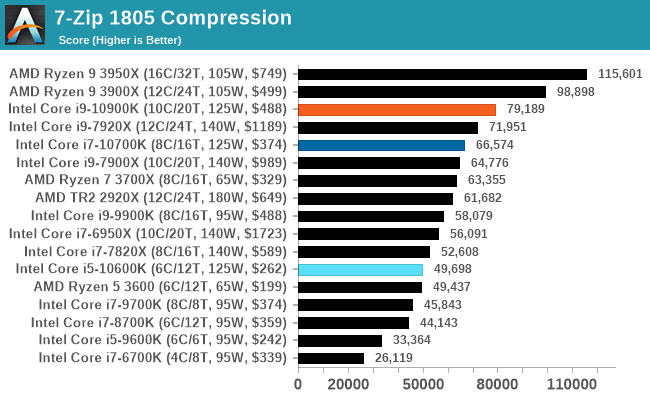
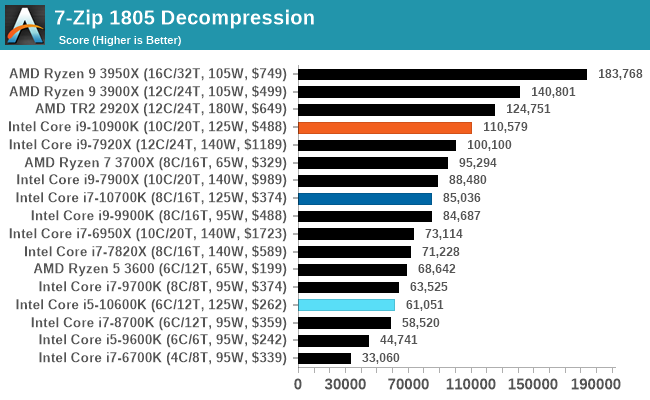

WinRAR 5.60b3: Archiving Tool
My compression tool of choice is often WinRAR, having been one of the first tools a number of my generation used over two decades ago. The interface has not changed much, although the integration with Windows right click commands is always a plus. It has no in-built test, so we run a compression over a set directory containing over thirty 60-second video files and 2000 small web-based files at a normal compression rate.
WinRAR is variable threaded but also susceptible to caching, so in our test we run it 10 times and take the average of the last five, leaving the test purely for raw CPU compute performance.
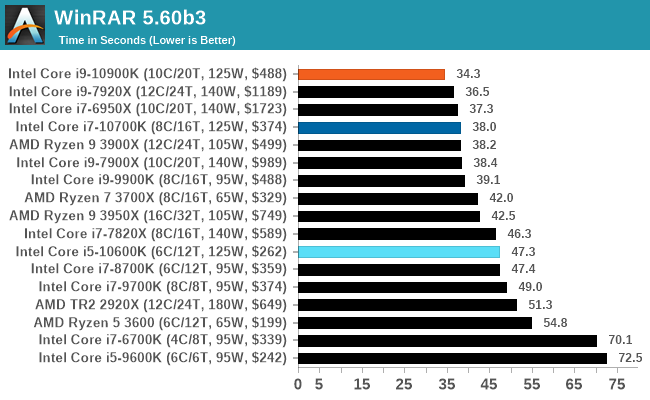
AES Encryption: File Security
A number of platforms, particularly mobile devices, are now offering encryption by default with file systems in order to protect the contents. Windows based devices have these options as well, often applied by BitLocker or third-party software. In our AES encryption test, we used the discontinued TrueCrypt for its built-in benchmark, which tests several encryption algorithms directly in memory.
The data we take for this test is the combined AES encrypt/decrypt performance, measured in gigabytes per second. The software does use AES commands for processors that offer hardware selection, however not AVX-512.
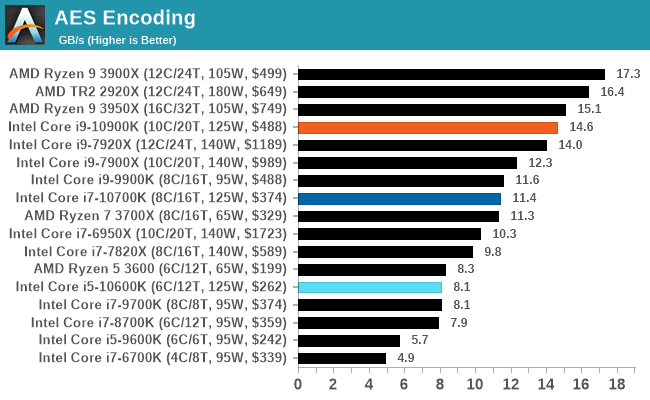
Handbrake 1.1.0: Streaming and Archival Video Transcoding
A popular open source tool, Handbrake is the anything-to-anything video conversion software that a number of people use as a reference point. The danger is always on version numbers and optimization, for example the latest versions of the software can take advantage of AVX-512 and OpenCL to accelerate certain types of transcoding and algorithms. The version we use here is a pure CPU play, with common transcoding variations.
We have split Handbrake up into several tests, using a Logitech C920 1080p60 native webcam recording (essentially a streamer recording), and convert them into two types of streaming formats and one for archival. The output settings used are:
- 720p60 at 6000 kbps constant bit rate, fast setting, high profile
- 1080p60 at 3500 kbps constant bit rate, faster setting, main profile
- 1080p60 HEVC at 3500 kbps variable bit rate, fast setting, main profile

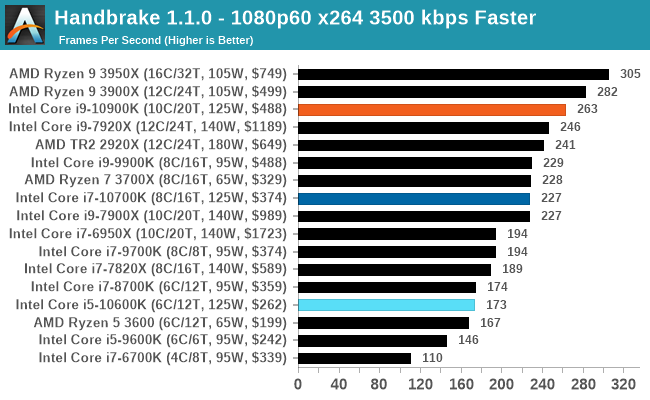
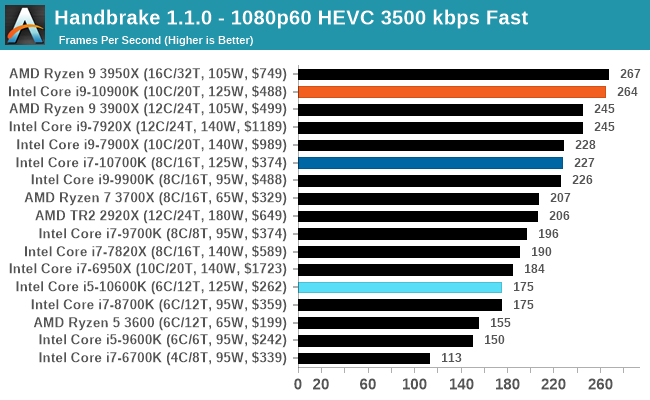










220 Comments
View All Comments
Ryan Smith - Tuesday, May 26, 2020 - link
To be sure, it's GTX 1080. IGP is the name of the setting.F123Nova - Saturday, May 23, 2020 - link
I am trying my best to be nice, but this article has the most dubious set of benchmarks I have seen, and the omission in the charts of Intel competition in certain charts where the competition is better makes me wonder why this article smells of a cash handout. Cant say for sure if this is another "Just buy it" piece, but it sure smells foul. I expected more from Anandtech...Ryan Smith - Tuesday, May 26, 2020 - link
Hi Nova,As has been the case for the past 23 years, we always strive to have accurate reporting, to the best of our abilities.
Given that we're in the process of rolling out some new benchmarks (such as the Crysis software render), we haven't yet had a chance to backfill in results for a number of processors. Unfortunately that's going to take some time. But in the meantime, was there any specific benchmark(s) you were concerned about? That might at least help us better prioritize what to backfill first.
And to be sure, there's no cash handout. That's not how we operate. (Selling out for anything less than an incredibly comfortable retirement isn't very helpful for our future employment prospects)
tvdang7 - Wednesday, May 27, 2020 - link
why couldnt AT use a 3800x instead of a 3700x.pcgpus - Friday, July 10, 2020 - link
Nice review. 10600K might be a new king in games (for fair price).If you want to compare this article with other services You have to go on this link:
https://warmbit.blogspot.com/2020/06/intel-core-10...
There are results from 9 services from 32 games!
After page load please pick up your language from google translate (right side of page).
pcgpus - Friday, July 10, 2020 - link
Nice review. 10900K is the new king in games!If you want to compare this article with other services You have to go on this link:
https://warmbit.blogspot.com/2020/06/intel-core-i9...
There are results from 9 services from 35 games!
After page load please pick up your language from google translate (right side of page).
Meteor2 - Wednesday, July 15, 2020 - link
A new microarchitecture doesn’t require a new process. When PAO immediately went south, I don’t understand why Intel didn’t just implement a new microarchitecture on 14 nm. Surely Ice Lake hasn’t taken four years to develop?Meteor2 - Wednesday, July 15, 2020 - link
*Sunny Cove. God Intel’s code-names are dumbmiss5tability - Saturday, August 8, 2020 - link
i just discovered this INTEL SCAM, now i dont freaking understand how those 10 gen cpu works i wanna buy i3 10300 and what im reading this is not 65W chip? what is real f@#%$@ power draw for those cpusdamian101 - Monday, August 10, 2020 - link
As far as I know Intel never used a single bidirectional ring bus on CPUs with more than 10 cores.On Intel Ivy Bridge CPUs with 12 and more (15) cores, Intel used three unidirectional ring buses. There were also no Sandy Bridge CPUs with more than 10 cores, and Intel used two bidirectional ring buses connected with buffered switches for their high core count Haswell CPUs.